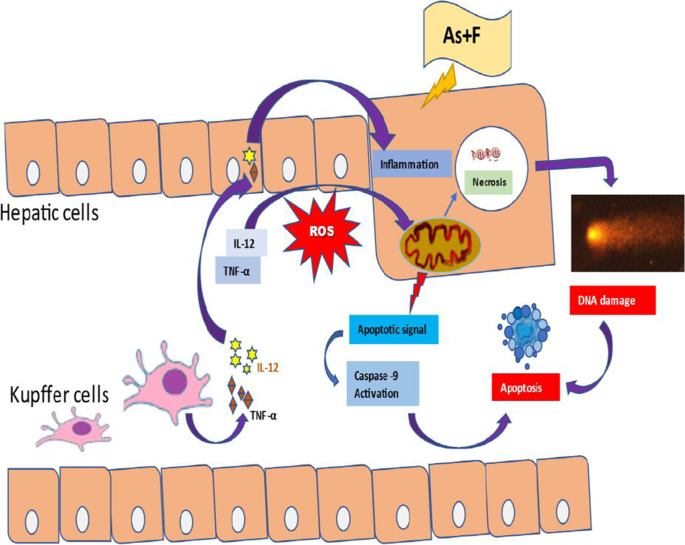Abstract
Health effects elicited by combined environmental exposures to xenobiotics, in many instances, still remain unresolved. One of these examples is the combined toxicity of arsenic and fluoride. The present study was undertaken to delineate the role of inflammation and apoptosis in hepatocellular death caused by co-exposure to arsenic and fluoride in rat. Sodium arsenate (4 mg/kg body weight) and sodium fluoride (4 mg/kg body weight) were administered to female Wistar rats, individually and in combination, for 90 days. Results on tumor necrotic factor-a (TNF-a), interleukin-12 (IL-12), and comet assay showed increased values in comparison to those obtained in arsenic- or fluoride-treated rats. Results on NO, TBARS, and caspase-9 showed higher values than fluoride-treated rats but lower levels than arsenic-treated rats. It is hypothesized that increased generation of nitric oxide induces the release of cytokines that activates caspase-9. Caspase-9 promotes the synthesis of caspase-3 that executes apoptosis. Histopathological observations on apoptotic bodies and Kupffer cells support these observations.
Graphical abstract

-
-
Co-exposure to Arsenic-Fluoride Results in Endoplasmic Reticulum Stress-Induced Apoptosis Through the PERK Signaling Pathway in the Liver of Offspring Rats.
Arsenic and fluoride are two of the major groundwater pollutants. To better understand the liver damage induced during development, 24 male rats exposed to fluoride (F), arsenic (As), and their combination (As + F) from the prenatal stage to 90 days after birth were selected for analysis. Histopathological results showed
-
Combined effect of arsenic and fluoride at environmentally relevant concentrations in zebrafish (Danio rerio) brain: Alterations in stress marker and apoptotic gene expression.
Highlights Arsenic and fluoride are the most common hazardous contaminant in the environment. Histological anomalies and alteration of oxidative stress parameters were evident. Stress responsive and apoptotic genes showed less pronounced effects upon co-exposure. DNA ladder was found in both individual treatment, not in combined. Elemental analysis and as3mt
-
A possible mechanism for combined arsenic and fluoride induced cellular and DNA damage in mice
Arsenic and fluoride are major contaminants of drinking water. Mechanisms of toxicity following individual exposure to arsenic or fluoride are well known. However, it is not explicit how combined exposure to arsenic and fluoride leads to cellular and/or DNA damage. The present study was planned to assess (i) oxidative stress
-
Effects of chronic fluorosis on the brain.
Highlights Reviewing the mechanism of brain injury caused by chronic fluorosis is of great significance for protecting residents in fluorosis endemic areas. Abstract This article reviews the effects of chronic fluorosis on the brain and possible mechanisms. We used PubMed, Medline and Cochraine databases to collect data on fluorosis, brain injury,
-
Arsenic and fluoride induce neural progenitor cell apoptosis.
The aim of the present study is to determine the effect of inorganic arsenic (As) and its metabolites on the viability of the neural progenitor cell (NPC) line C17.2, in order to evaluate cellular mechanisms involved in As developmental neurotoxicity. Moreover, we analyzed the effects of the coexposure to As
Related Studies :
-
-
-
Unheeded Warnings: Government Health Authorities Ignore Fluoride Risk for Kidney Patients
Despite the well known fact that individuals with kidney disease are at much higher risk of fluoride toxicity than the general population, there has yet to be any attempt in the United States, or any other country that practices mass-scale water fluoridation to determine the prevalence of fluoride-related effects (e.g.,
-
Factors which increase the risk for skeletal fluorosis
The risk for developing skeletal fluorosis, and the course the disease will take, is not solely dependent on the dose of fluoride ingested. Indeed, people exposed to similar doses of fluoride may experience markedly different effects. While the wide range in individual response to fluoride is not yet fully understood, the following are some of the factors that are believed to play a role.
-
Fluoride Exposure Aggravates the Impact of Iodine Deficiency
A consistent body of animal and human research shows that fluoride exposure worsens the impact of an iodine deficiency. Iodine is the basic building block of the T3 and T4 hormones and thus an adequate iodine intake is essential for the proper functioning of the thyroid gland. When iodine intake is inadequate during infancy and
-
Fluoridated Water Causes Severe Dental Fluorosis in Children with Diabetes Insipidus
This section on Diabetes includes: • Fluoride & Impaired Glucose Tolerance • Fluoride & Insulin • Fluoride Sensitivity Among Diabetics • Fluoridated Water Causes Severe Dental Fluorosis in Children with Diabetes Insipidus • NRC (2006): Fluoride’s Effect on Glucose Metabolism Excessive exposure to fluoride causes a defect of the tooth enamel known as dental fluorosis. In
-
Skeletal Fluorosis & Individual Variability
One of the common fallacies in the research on skeletal fluorosis is the notion that there is a uniform level of fluoride that is safe for everyone in the population. These "safety thresholds" have been expressed in terms of (a) bone fluoride content, (b) daily dose, (c) water fluoride level, (d) urinary fluoride level, and (e) blood fluoride level. The central fallacy with each of these alleged safety thresholds, however, is that they ignore the wide range of individual susceptibility in how people respond to toxic substances, including fluoride.
Related FAN Content :
-
